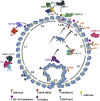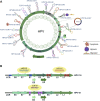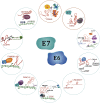Epigenetic and Transcriptomic Regulation Landscape in HPV+ Cancers: Biological and Clinical Implications
- PMID: 35774512
- PMCID: PMC9237502
- DOI: 10.3389/fgene.2022.886613
Epigenetic and Transcriptomic Regulation Landscape in HPV+ Cancers: Biological and Clinical Implications
Abstract
Human Papillomavirus (HPV) is an oncogenic virus that causes the highest number of viral-associated cancer cases and deaths worldwide, with more than 690,000 new cases per year and 342,000 deaths only for cervical cancer (CC). Although the incidence and mortality rates for CC are declining in countries where screening and vaccination programs have been implemented, other types of cancer in which HPV is involved, such as oropharyngeal cancer, are increasing, particularly in men. Mutational and transcriptional profiles of various HPV-associated neoplasms have been described, and accumulated evidence has shown the oncogenic capacity of E6, E7, and E5 genes of high-risk HPV. Interestingly, transcriptomic analysis has revealed that although a vast majority of the human genome is transcribed into RNAs, only 2% of transcripts are translated into proteins. The remaining transcripts lacking protein-coding potential are called non-coding RNAs. In addition to the transfer and ribosomal RNAs, there are regulatory non-coding RNAs classified according to size and structure in long non-coding RNAs (lncRNAs), circular RNAs (circRNAs), and small RNAs; such as microRNAs (miRNAs), piwi-associated RNAs (piRNAs), small nucleolar RNAs (snoRNAs) and endogenous short-interfering RNAs. Recent evidence has shown that lncRNAs, miRNAs, and circRNAs are aberrantly expressed under pathological conditions such as cancer. In addition, those transcripts are dysregulated in HPV-related neoplasms, and their expression correlates with tumor progression, metastasis, poor prognosis, and recurrence. Nuclear lncRNAs are epigenetic regulators involved in controlling gene expression at the transcriptional level through chromatin modification and remodeling. Moreover, disruption of the expression profiles of those lncRNAs affects multiple biological processes such as cell proliferation, apoptosis, and migration. This review highlights the epigenetic alterations induced by HPV, from infection to neoplastic transformation. We condense the epigenetic role of non-coding RNA alterations and their potential as biomarkers in transformation's early stages and clinical applications. We also summarize the molecular mechanisms of action of nuclear lncRNAs to understand better their role in the epigenetic control of gene expression and how they can drive the malignant phenotype of HPV-related neoplasia. Finally, we review several chemical and epigenetic therapy options to prevent and treat HPV-associated neoplasms.
Keywords: HPV; LncRNA; biomarker; epigenetic; miRNA; regulation; therapy; viral oncoprotein.
Copyright © 2022 Castro-Oropeza and Piña-Sánchez.
Conflict of interest statement
The authors declare that the research was conducted in the absence of any commercial or financial relationships that could be construed as a potential conflict of interest.
Figures





Similar articles
-
The Role of microRNAs, Long Non-coding RNAs, and Circular RNAs in Cervical Cancer.Front Oncol. 2020 Feb 20;10:150. doi: 10.3389/fonc.2020.00150. eCollection 2020. Front Oncol. 2020. PMID: 32154165 Free PMC article. Review.
-
Identification of Novel Long Non-coding and Circular RNAs in Human Papillomavirus-Mediated Cervical Cancer.Front Microbiol. 2017 Sep 19;8:1720. doi: 10.3389/fmicb.2017.01720. eCollection 2017. Front Microbiol. 2017. PMID: 28970820 Free PMC article.
-
Comprehensive analysis of lncRNA-mRNA co-expression networks in HPV-driven cervical cancer reveals the pivotal function of LINC00511-PGK1 in tumorigenesis.Comput Biol Med. 2023 Jun;159:106943. doi: 10.1016/j.compbiomed.2023.106943. Epub 2023 Apr 20. Comput Biol Med. 2023. PMID: 37099974
-
Non-Coding RNAs as Mediators of Epigenetic Changes in Malignancies.Cancers (Basel). 2020 Dec 5;12(12):3657. doi: 10.3390/cancers12123657. Cancers (Basel). 2020. PMID: 33291485 Free PMC article. Review.
-
Coordinated action of human papillomavirus type 16 E6 and E7 oncoproteins on competitive endogenous RNA (ceRNA) network members in primary human keratinocytes.BMC Cancer. 2021 Jun 7;21(1):673. doi: 10.1186/s12885-021-08361-y. BMC Cancer. 2021. PMID: 34098875 Free PMC article.
Cited by
-
Elucidating the clonal relationship of esophageal second primary tumors in patients with laryngeal squamous cell carcinoma.Infect Agent Cancer. 2023 Nov 28;18(1):75. doi: 10.1186/s13027-023-00558-z. Infect Agent Cancer. 2023. PMID: 38017473 Free PMC article. Review.
-
Epigenetic and Genetic Keys to Fight HPV-Related Cancers.Cancers (Basel). 2023 Nov 25;15(23):5583. doi: 10.3390/cancers15235583. Cancers (Basel). 2023. PMID: 38067286 Free PMC article. Review.
-
The Role of Biomarkers in HPV-Positive Head and Neck Squamous Cell Carcinoma: Towards Precision Medicine.Diagnostics (Basel). 2024 Jul 7;14(13):1448. doi: 10.3390/diagnostics14131448. Diagnostics (Basel). 2024. PMID: 39001338 Free PMC article. Review.
-
The role of pioneering transcription factors, chromatin accessibility and epigenetic reprogramming in oncogenic viruses.Front Microbiol. 2025 Jun 16;16:1602497. doi: 10.3389/fmicb.2025.1602497. eCollection 2025. Front Microbiol. 2025. PMID: 40589575 Free PMC article. Review.
-
Emerging paradigms: unmasking the role of oxidative stress in HPV-induced carcinogenesis.Infect Agent Cancer. 2024 Jul 2;19(1):30. doi: 10.1186/s13027-024-00581-8. Infect Agent Cancer. 2024. PMID: 38956668 Free PMC article. Review.
References
-
- Amaro-Filho S. M., Pereira Chaves C. B., Felix S. P., Basto D. L., de Almeida L. M., Moreira M. A. M. (2018). HPV DNA Methylation at the Early Promoter and E1/E2 Integrity: A Comparison between HPV16, HPV18 and HPV45 in Cervical Cancer. Papillomavirus Res. 5, 172–179. 10.1016/j.pvr.2018.04.002 - DOI - PMC - PubMed
-
- Babion I., Snoek B. C., Novianti P. W., Jaspers A., van Trommel N., Heideman D. A. M., et al. (2018). Triage of High-Risk HPV-Positive Women in Population-Based Screening by miRNA Expression Analysis in Cervical Scrapes; a Feasibility Study. Clin. Epigenet 10, 76. 10.1186/s13148-018-0509-9 - DOI - PMC - PubMed
Publication types
LinkOut - more resources
Full Text Sources

